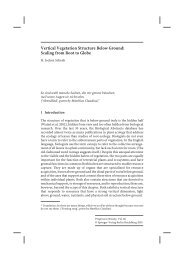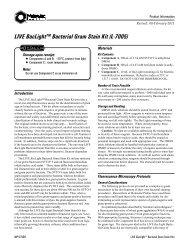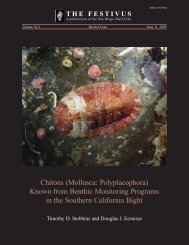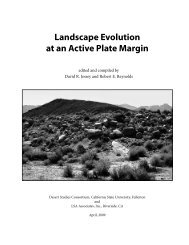2010 Overboard in the Mojave - Biological Science - California State ...
2010 Overboard in the Mojave - Biological Science - California State ...
2010 Overboard in the Mojave - Biological Science - California State ...
You also want an ePaper? Increase the reach of your titles
YUMPU automatically turns print PDFs into web optimized ePapers that Google loves.
m. c. reheis and d. m. miller<br />
Figure 5. Distal fluvial-deltaic and mudflat deposits. A, segment MX-11 of <strong>the</strong> USGS Manix core shows fluvial f<strong>in</strong><strong>in</strong>gupward<br />
sequences with clay rip-ups and mudcracks. Photograph by J. Honke, U.S. Geological Survey. B, oscillat<strong>in</strong>g<br />
shallow-water and mudflat deposits exposed on <strong>the</strong> sou<strong>the</strong>astern marg<strong>in</strong> of <strong>the</strong> Coyote Lake subbas<strong>in</strong>. Numbers mark<br />
10-cm <strong>in</strong>crements on scale. Photograph by D. Miller. C, vertisols formed on desiccated lake sediments<br />
tion, proximity to <strong>the</strong> encroach<strong>in</strong>g front of <strong>the</strong> <strong>Mojave</strong><br />
fluvial fan <strong>in</strong>creased <strong>the</strong> frequency of <strong>in</strong>cursion of fluvial<br />
sediment dur<strong>in</strong>g low to moderate lake levels.<br />
The distal deltaic and mudflat deposits typically<br />
consist of normally graded sequences of sand, silt, and<br />
clay (Figure 5A). The basal arkosic, coarse- to mediumgra<strong>in</strong>ed<br />
sands are commonly oxidized and locally crossbedded.<br />
In some <strong>in</strong>tervals <strong>the</strong>y grade up through th<strong>in</strong>ly<br />
bedded and sorted, pale gray, very f<strong>in</strong>e-gra<strong>in</strong>ed sand<br />
and silt to lam<strong>in</strong>ated clay and silt, suggest<strong>in</strong>g delta-front<br />
sedimentation. In o<strong>the</strong>r <strong>in</strong>tervals, <strong>in</strong>terpreted as fluvial<br />
sedimentation on a mudflat surface possibly from a s<strong>in</strong>gle<br />
flood<strong>in</strong>g event, <strong>the</strong> sands grade up through brown muddy<br />
sand and sandy mud to blocky clay with burrows and<br />
sand-filled cracks. Some f<strong>in</strong>e-gra<strong>in</strong>ed beds appear con-<br />
torted and brecciated, and some sand beds are mixed with<br />
rip-up mud clasts. Muds that are cracked and oxidized<br />
(7.5 to 5 YR colors) are <strong>in</strong>terpreted to represent episodes<br />
of soil formation on an exposed mudflat. These sequences<br />
differ from sandflats and mudflats previously described<br />
for <strong>the</strong> marg<strong>in</strong>s of arid closed bas<strong>in</strong>s (e.g., Talbot and Allen,<br />
1996) because of <strong>the</strong> <strong>in</strong>fluence of <strong>the</strong> <strong>Mojave</strong> River.<br />
O<strong>the</strong>r mudflat deposits <strong>in</strong> <strong>the</strong> Manix bas<strong>in</strong>, such as <strong>in</strong><br />
<strong>the</strong> Coyote subbas<strong>in</strong> (Fig. 5C), share some characteristics<br />
with <strong>the</strong> distal deltaic deposits <strong>in</strong> that <strong>the</strong>y are characterized<br />
by rapidly chang<strong>in</strong>g, <strong>in</strong>terbedded, f<strong>in</strong><strong>in</strong>g-upward<br />
sand, silt, and clay beds, with <strong>the</strong> clays cracked and<br />
oxidized. However, <strong>the</strong>y lack evidence for fluvial sediment<br />
transport, and <strong>in</strong>stead are similar to <strong>the</strong> sandflat and<br />
mudflat environments of o<strong>the</strong>r closed-bas<strong>in</strong> lakes (Allen<br />
30 <strong>2010</strong> Desert Symposium
















